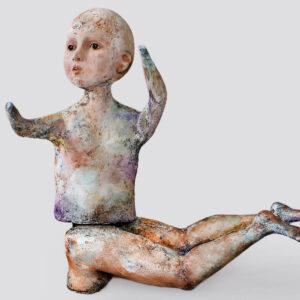Within Flesh and Bones
Solo Exhibition By Maryam Kouhestani1 to 15 October 2021Maryam Koohestani was born in 1982 in the Iranian city of Zahedan and she holds a Master’s degree in Art Research from Tabriz University.
“Within Flesh and Bone” is Maryam’s thirteenth solo exhibition and her first collaboration with INJA Gallery. This series includes 8 ceramic sculptures in different dimensions.
Maryam is a sculptor whose principal artistic themes are the body and figure. ‘Within Flesh and Bone’ makes overt and clear reference to relations between humans. In this series, the body, which is often without gender, is merely a familiar means to express the situations and spaces she hopes to share with the audience.
In addition to her artistic work, Maryam is active as a university lecturer and social activist, having also taken part in more than twenty group exhibitions and competitions inside Iran and abroad.
Within Flesh and Bones
In her reflections and the creation of her sculptures, Maryam Koohestani constantly seeks a dynamic, profound, and mobile structure, and in this series as well, she has been able to link the relations between ideas and practical capacities in her work with an approach of interactive art. However, her excessive interest and dependence on the “body” and figurative perspective exhibits a meaningful and even abstract narrative which can build a profound aesthetic connection to the artist’s reflections in this series of works.
In this series, Koohestani emphasizes one’s relations with oneself and others and the absence of the notion of relations in a space replete with suspension. This time around, the components of her sculptures can be manipulated by the audience and, in different arrangements, each work gains a new semantic function. It is through this same feature that, by moving beyond the concepts of “identity” and “gender”, she makes clear reference to an unknown but profound place in the audience’s subconscious; this is a shared experience in the field of form and movement which is reminiscent of the characteristics of today’s modernist sculpting, despite the fact that it clearly bears no time or space.
The excessive clarity of the artist’s subjects and mental maneuvers puts emphasis on content that has been present in her sculptures from the past, but this has never been as overt as in this series and her approach toward and interpretation of these imperfect “humans” is profound and dramatic in itself; what broadens Koohestani’s intended meaning and superstructure is the general discipline in form and content which is put on display not through critique and a formative perspective, but through sensory interaction based on a personal account of the artist’s relation with her body.
–
Kianoosh Motaghedi
Fall 2021





















